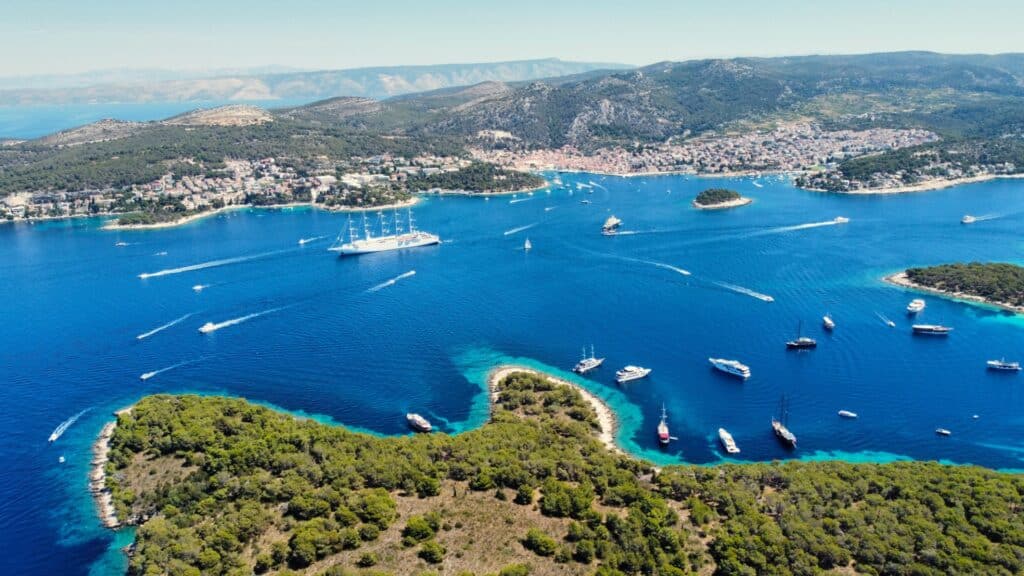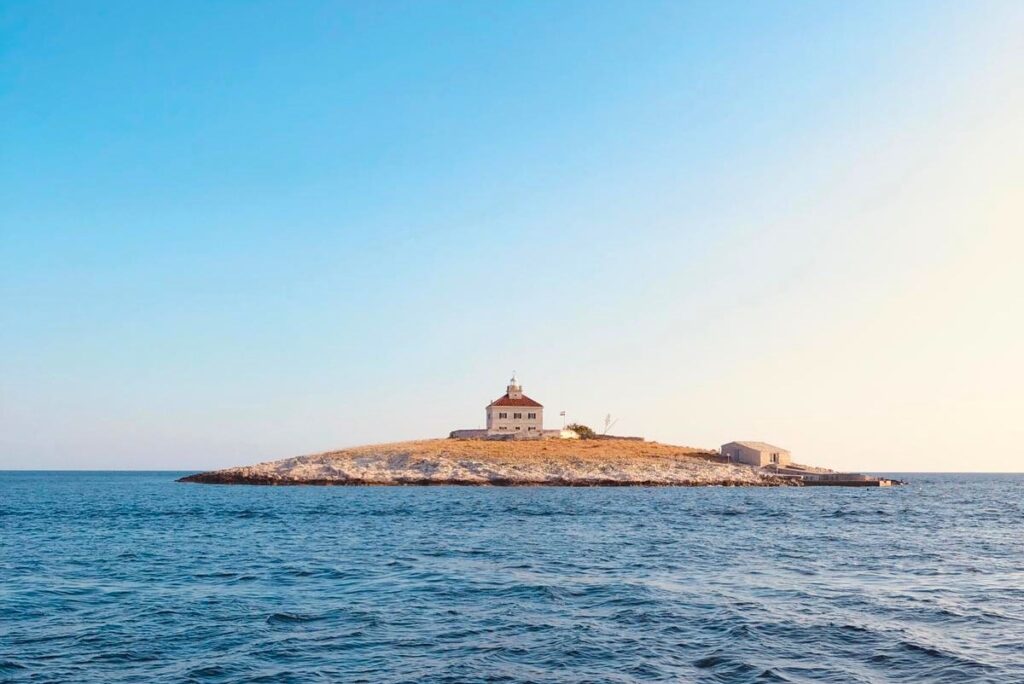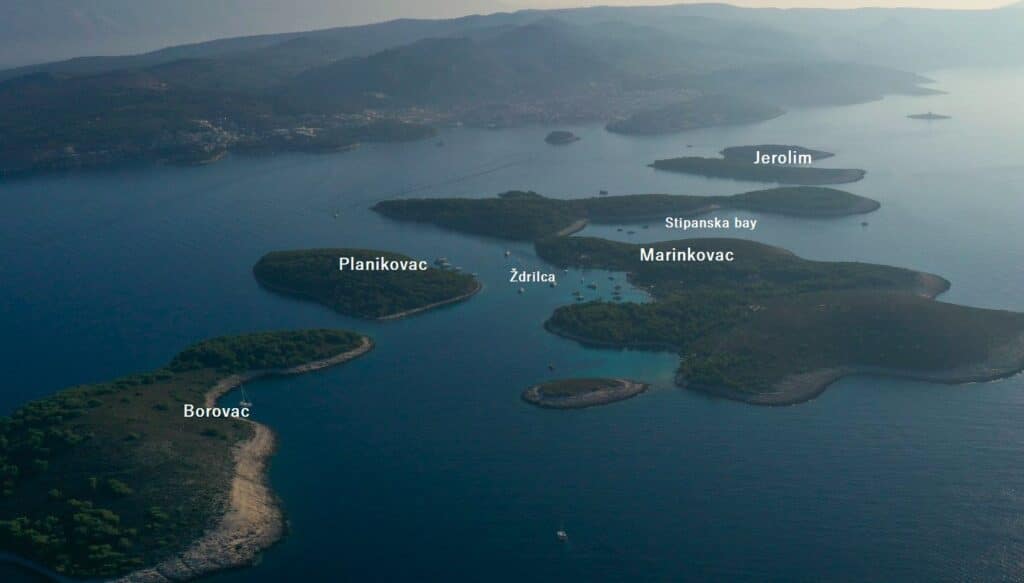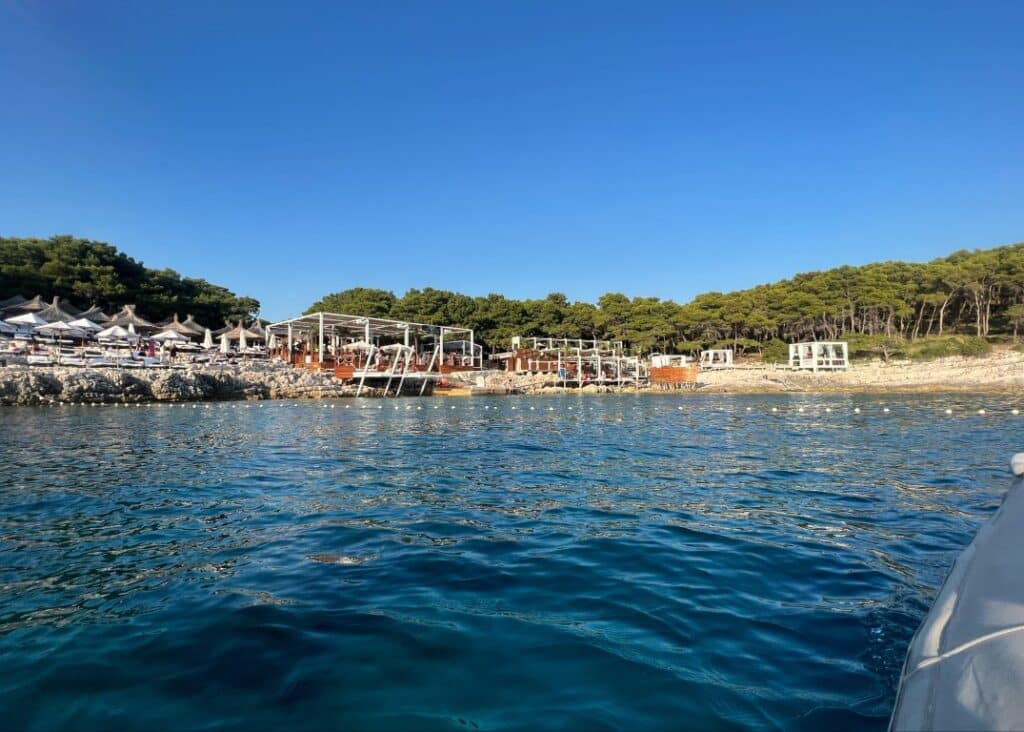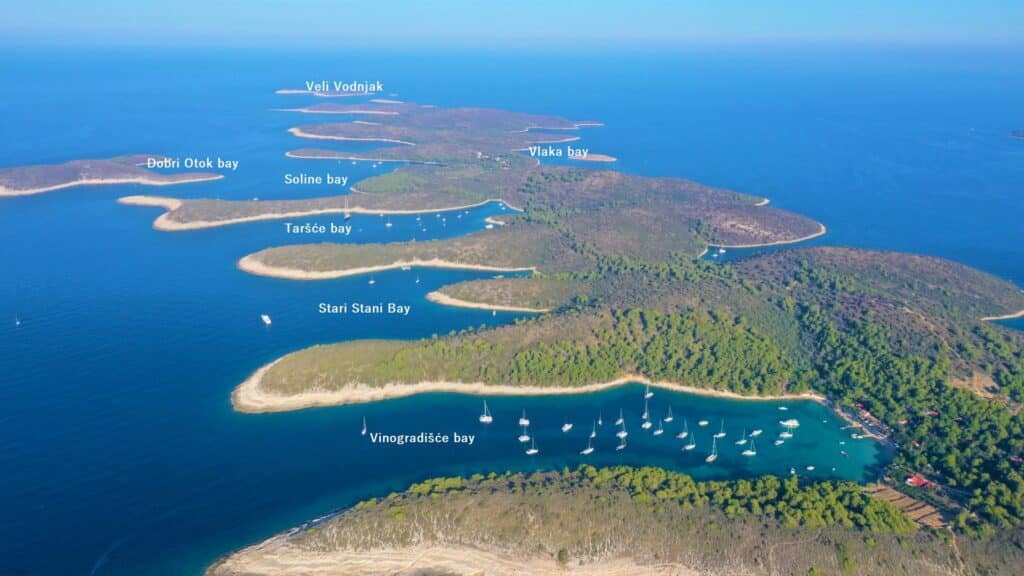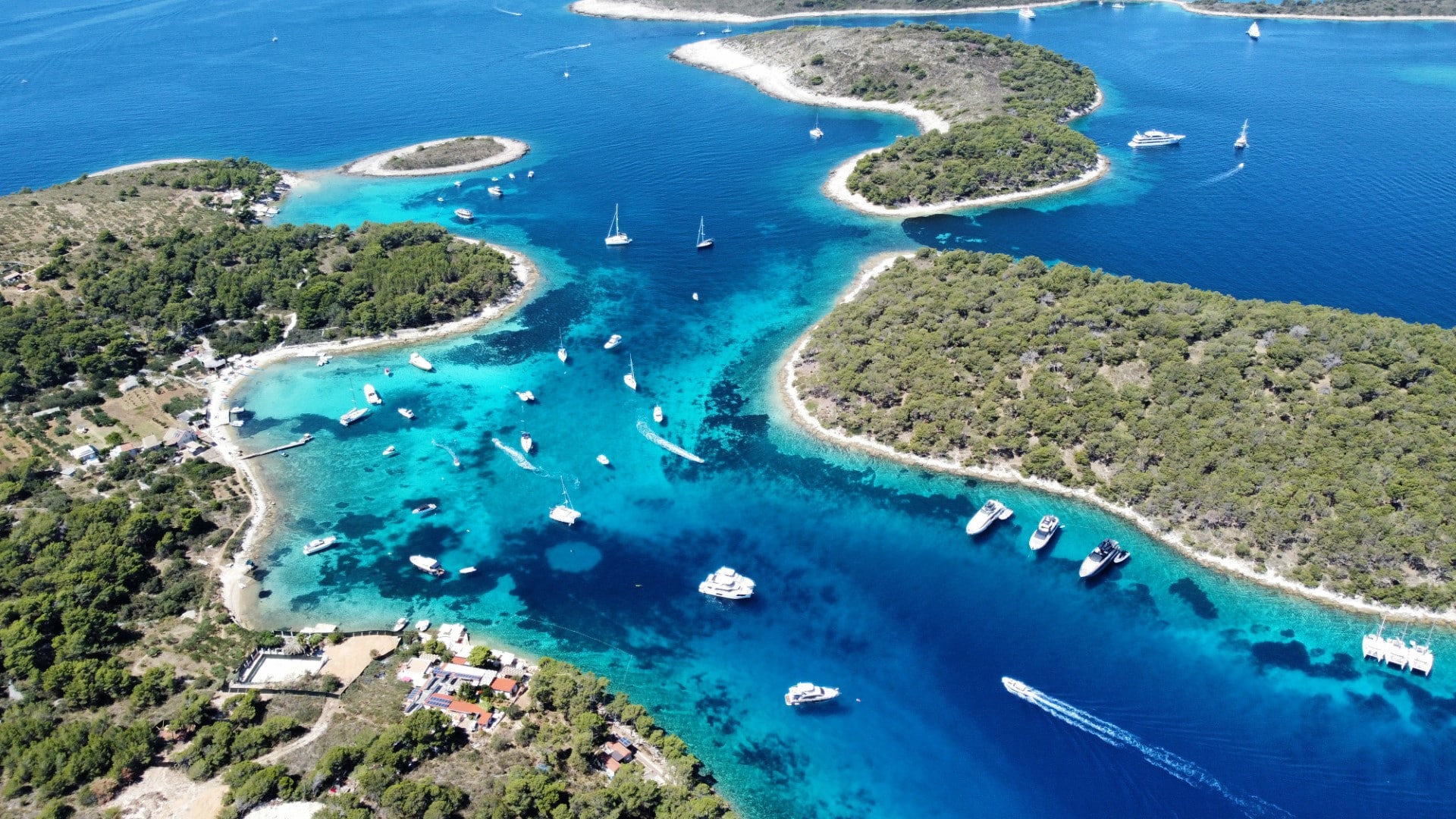
- Sailing Croatia tips
-
by Ultra Sailing Team
In the height of summer, especially in August, the bays of the Pakleni Islands can look like a „floating city“. On a single day, you might spot well over a thousand yachts, sailing boats and motorboats dropping anchor in this small but stunning archipelago just off Hvar Town. Nowhere else in the Adriatic seems to hold the same irresistible magnetism for sailors.
It isn’t just boaters who flock here. Day-trippers from Hvar, sun-seekers in search of beach clubs, food lovers, divers, and party crowds all converge on the coves of Sveti Jerolim, Stipanska, Zdrilca, and Palmižana. Water taxis and excursion boats shuttle back and forth from Hvar like busy bees, creating the impression of a buzzing summer playground.
At first, the Pakleni Islands might look like any other popular Adriatic swimming spot. But this cluster of more than a dozen islets is different. Apart from a handful of restaurants and beach bars, the islands are uninhabited and wilder than they appear at first glance. Wander along the pine-scented paths, discover moorings tucked into sheltered coves, or dive into the history that shaped these shores, and a deeper character reveals itself.
Sailors who take their time here rarely leave with just one memory. Instead, the Pakleni Islands offer a mosaic of impressions, quiet anchorages, lively beach clubs, and hidden corners that keep drawing you back for more.
Pokonji Dol – The eastern gateway
The chain of Pakleni Islands stretches across 21 islands, islets, and rocky outcrops, with its “bookends” marked by lighthouses: Pokonji Dol in the east and Veli Vodnjak in the west.
Pokonji Dol Lighthouse, built in 1872 under the Austro-Hungarian Empire, is one of those picture-perfect Adriatic lighthouses that looks like it belongs on a postcard. Perched on a small round islet just off Hvar Town, it once housed lighthouse keepers and their families for generations. With automation, the keepers left, and the residence later became available for private use.
For sailors, Pokonji Dol is more of a landmark than a true anchorage. The islet is only suitable for very small boats or dinghies, most skippers use it as a scenic waypoint rather than a stopover. It does, however, signal the beginning of our exploration of the Pakleni Islands.
Jerolim – beaches and naturist island
A little further west lies Jerolim (also St. Jerolim), instantly recognizable from above by its teardrop shape split by a narrow passage. Its white beaches stretch along both the northern and southern shores, making it one of the most popular islands for swimming and relaxing.
Anchoring here requires some care. The designated swimming areas are protected by floating barriers, so boats must drop anchor outside the marked zones. Smaller boats and dinghies can tuck in closer along the rocky shoreline, where you’ll find a few inviting spots. Depths vary, so good ground tackle and a stern line to shore are recommended if you want to stay secure.
The north bay has a larger pier, while the south offers a smaller one, both mainly used by the Barkarijoli, Hvar’s local boatmen who ferry guests back and forth.
Jerolim also has a curious history. The island takes its name from the Augustinian monk Jerolim Grivićić, who lived here in the late 15th century. Centuries later, it became the first of the Pakleni Islands to welcome tourists, and even today it retains its reputation as a nudist-friendly beach destination. A short stroll across the island offers great views and a relaxed atmosphere, with plenty of fellow visitors exploring on foot.
Marinkovac – Party vibes and shelter in Stipanska Bay
Just west of Jerolim lies Marinkovac, the second-largest of the Pakleni Islands. On its eastern side, excursion boats line up at the piers to drop passengers at the famous Carpe Diem Beach Bar, a hotspot that attracts visitors day and night. If you’re looking for cocktails, beach parties, and nightlife, this is the place. If, however, you’re seeking a quiet night at anchor, it’s best to look further west. Marinkovac has a long history of habitation, stretching back to ancient times, but today its identity is tied closely to tourism. Stipanska Bay, home to Carpe Diem Beach Bar, is particularly popular with younger travelers. By day, it’s all about beach vibes; by night, it turns into one of the Adriatic’s most famous open-air clubs. For sailors, the bay is also practical: it offers decent shelter from the bura (NE winds) and westerlies, making it a safe stop despite the lively atmosphere. There are nor mooring buoys here.
Zdrilca Passage – A classic anchorage with dining options
On the western side of Marinkovac, the mood shifts completely. Here, sheltered by the smaller wooded islets of Planikovac and Borovac, lies the Zdrilca Passage, it is one of the best-known anchorages in the entire Pakleni chain.


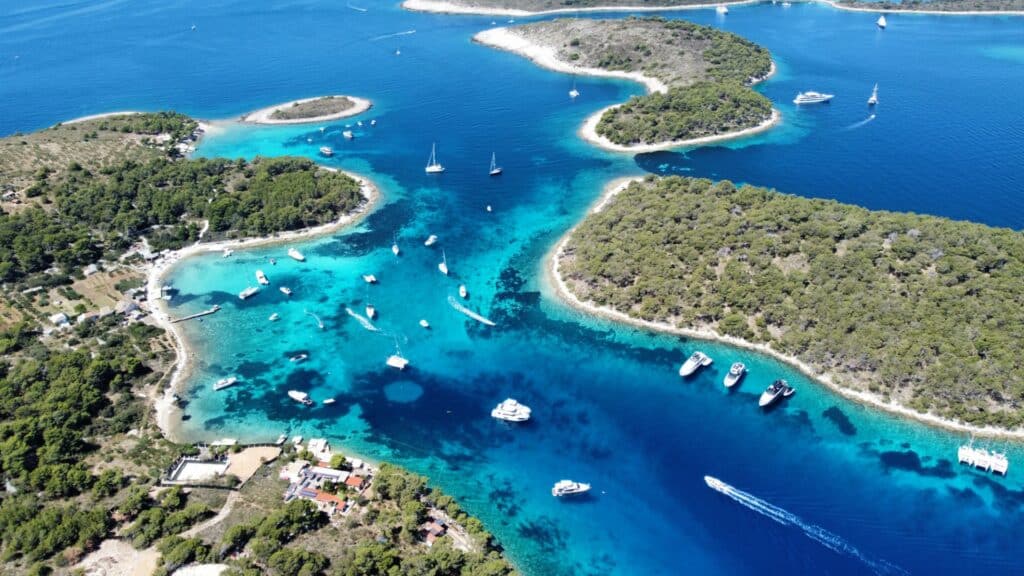
In summer, it’s common to see 40–50 boats anchored or moored here. Smaller boats usually tie to the buoys or drop anchor in the shallower central area, while larger yachts often settle just outside the passages or along the shores of the islets. Many skippers secure their boats with a stern line to the rocks for extra stability. The holding is generally reliable, but space fills up quickly during July and August, so it’s wise to arrive before midday if you want a good spot.
What makes Zdrilca especially attractive is not just the anchorage, but also the shore. A long pebble beach connects a trio of popular restaurants and bars: Patak, Tri Grede, and Mamato Bar. Each offers its own twist on Dalmatian cuisine, fresh seafood, and summer cocktails, making this one of the few places in the Pakleni Islands where you can step off your boat and straight into a seaside dining experience.
Sveti Klement – The biggest of the Pakleni Archipelago
The largest of the Pakleni Islands is Sveti Klement. Despite its modest size, this island is packed with history, natural beauty, and some of the most famous anchorages in the Adriatic. Burial mounds and Roman remains show that Sveti Klement has been inhabited since prehistoric times, and today it remains the beating heart of the Pakleni chain.
Palmizana – Marina and gateway to the Islands
On the north side lies Palmizana Bay, home to the ACI Marina Palmizana, open from April through October. The marina has around 180 berths and is well-equipped, making it one of the safest and most convenient mooring options for skippers exploring the islands. Reservations can be made online, which is strongly recommended in July and August when space fills quickly.


Palmizana is more than just a marina, though. Excursion boats from Hvar also arrive here, and the bay itself is surrounded by pine forests, botanical gardens, and family-run restaurants. It’s also a stop for several famous party flotillas, when dozens of sailing yachts and catamarans turn the bay into a floating festival.
Sailor’s tip: Palmizana provides excellent shelter from most winds, but in strong bura conditions, it can be choppy. Arrive early if you want a berth, as afternoon queues are the norm in high season.
Vinogradisce Bay – Restaurants, scenery and anchoring buzz
Just a short walk across the island from Palmizana lies Vinogradisce Bay on the southern shore, one of the most famous and crowded anchorages in Croatia. In summer, the bay is lined with sailboats, catamarans, and yachts, all drawn by its turquoise water, sandy seabed, and lively restaurant scene.
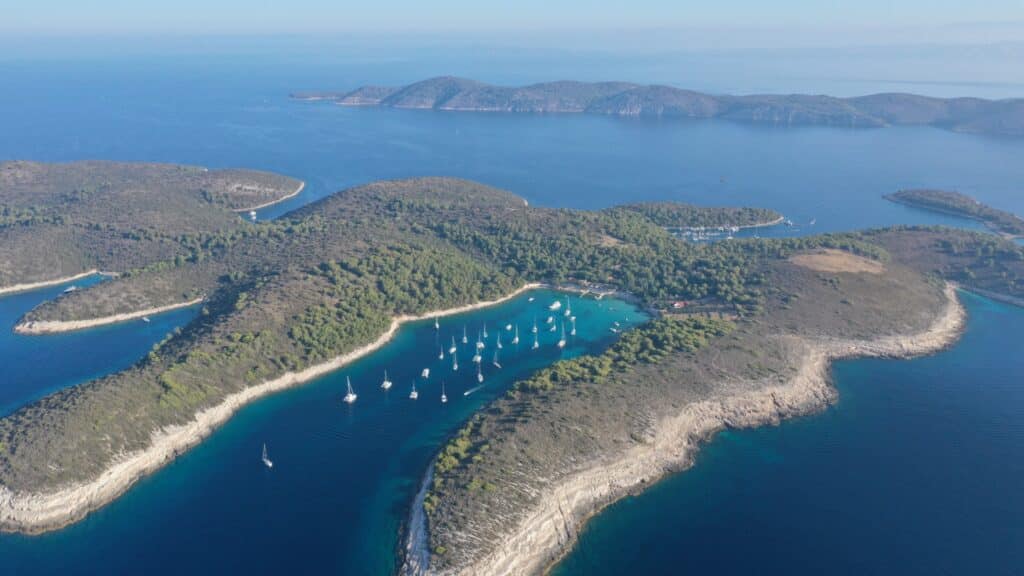
Here you’ll find five well-known restaurants, where guests often dine with their dinghies tied up just meters away. Because the anchoring field is leased and monitored, spots are relatively organized, but they fill up very quickly.
Sailor’s tip: Vinogradisce is best enjoyed in early summer or late September, when it’s easier to find space and the vibe is more relaxed. If you arrive in peak season, plan to secure a buoy early in the day or consider mooring in Palmizana Marina and walking over for dinner or take a water taxi to the Hvar Town.
Tarsce and Soline Bays – Quiet beauty
For those craving more peace, sailing west from Vinogradisce rewards you with several quiet hideaways. First comes Stari Stani Bay, followed by the strikingly picturesque Tarsce Bay, a favorite among experienced sailors for its tranquility and reliable holding. Further along lies expansive Soline Bay, actually made up of three smaller coves, Solinte, Privojnica and Pod Lozje, tucked behind Dobri Otok, a small islet that provides shelter from southerly winds.
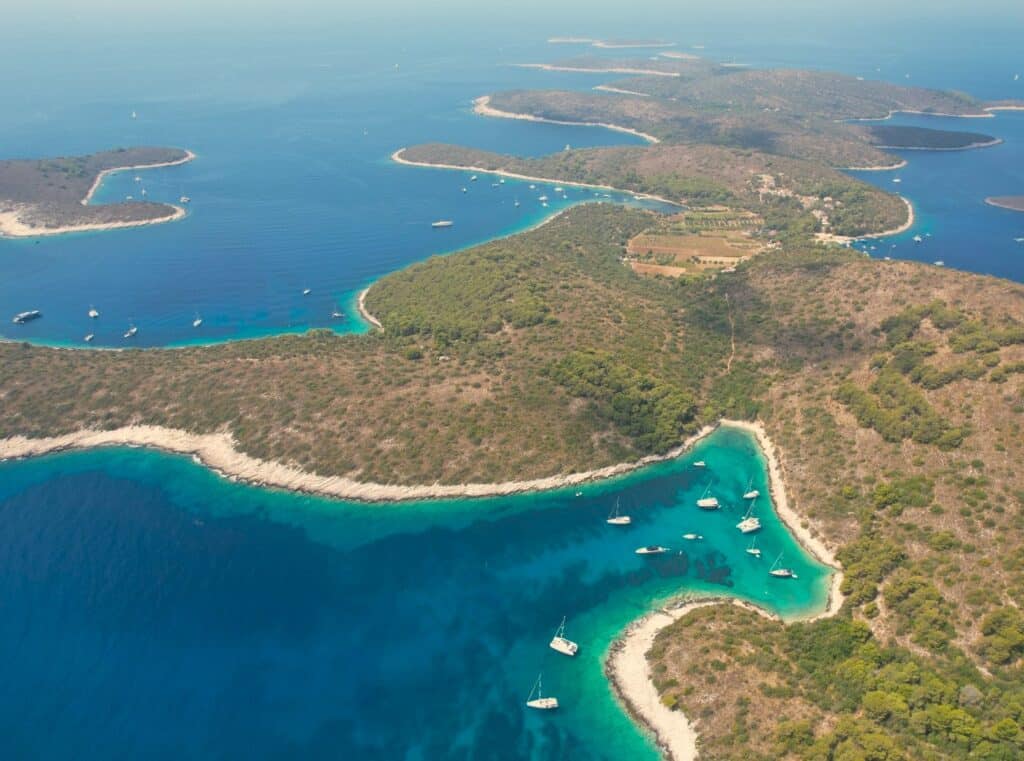
The seabed in the shallow western arm of Soline is covered in dark, mineral-rich mud, which some locals call “healing mud.” Not so long ago, these bays saw few visitors, but with the rise of charter business, more boats now seek out their serenity. Still, compared to Vinogradisce, they remain a refuge of calm.
Sailor’s tip: Soline and Tarsce are ideal overnight stops in calm weather, but they can get uncomfortable in stronger southerlies despite Dobri Otok’s protection.
Vlaka Bay – Tradition and Simplicity
On the northern shore, opposite Soline and Tarsce, lies Vlaka Bay. This is the oldest settlement on Sveti Klement and today home to the well-known „Fisherman’s House“ restaurant, a favorite among sailors for its fresh seafood and authentic atmosphere. About 12 buoys are maintained here for visiting boats, and the bay offers good shelter from southeasterly winds.
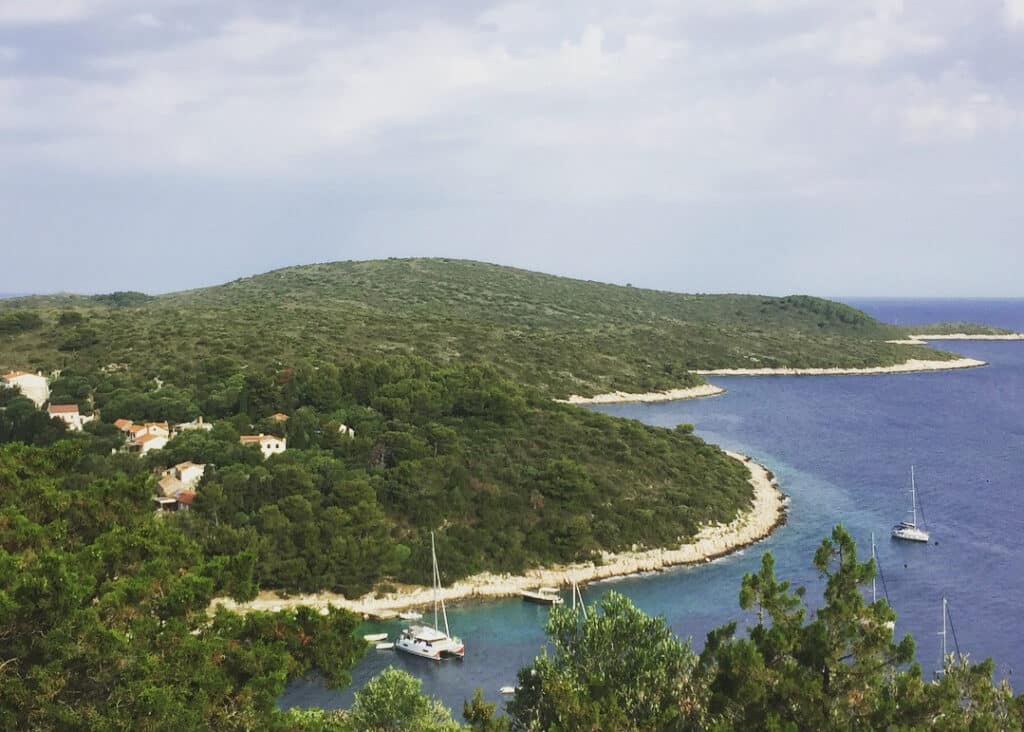
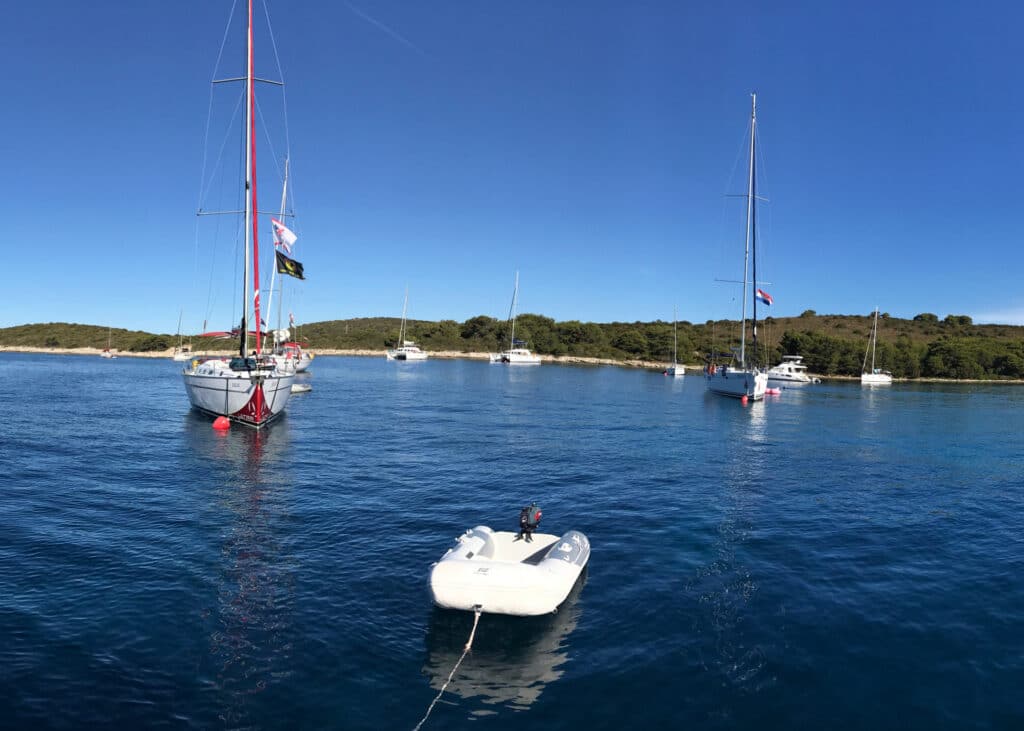
Vlaka still feels slower and more traditional than the busier bays nearby. Paths lined with rosemary and heather lead you into the island’s interior, where the air is scented with wild herbs, and life moves at a pace unchanged for decades.
Vodnjak – The western edge of the Pakleni Islands
Beyond Sveti Klement, a scattered chain of rocky islets and reefs marks the outer rim of the Pakleni Archipelago. Small Islets like Borovac, Prazanj, Lengva, Trovna, Vodnjak Mali, and Vodnjak Veli dot the charts, though most are little more than barren rocks rising from the sea.
The largest of them, Veli Vodnjak, carries a lighthouse on its southwestern tip, facing toward the island of Vis. Built to guide ships safely along this busy channel, the lighthouse still serves as a striking landmark for sailors approaching from the open sea. There is a small jetty nearby, originally for lighthouse service boats, but visiting sailors can also use it if conditions allow.
Whether you come for the lively beach bars of Marinkovac, the fine dining in Vinogradisce, or the quiet anchorages of Tarsce and Soline, the Pakleni Islands offer a rare mix of contrasts, from buzzing party bays to serene, pine-scented coves.
Best times to visit: June and September are ideal months, with warm weather, calmer crowds, and more space at anchorages. July and August bring the most energy and nightlife but also the tightest mooring spots.
The Pakleni Islands may be small on the map, but for sailors, they represent an entire world of experiences and once you’ve explored them, chances are you’ll be drawn back to discover even more.
